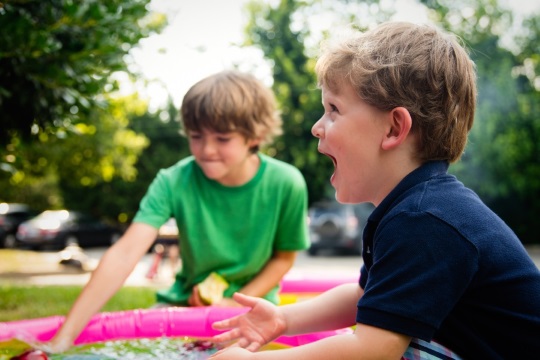

Speech and language? Is speech the same as language? Actually, there is quite a difference between speech and language, although speech is generally a part of language (there is also written and signed language). Speech is the physical process of making sounds that make sense and have meaning – in other words, a person’s voice and articulation. All the rest is language. This includes all the words a person uses and understands, the phrases and sentences of whichever language he is speaking, and the knowledge of how to communicate appropriately with others. An easy way to think about all of this is to group speech and language skills into categories.
There are 6 categories of language development that need attention right from birth. Yes, from birth! We can call these “The Super 6” of speech and language development:

1. Sounds (Phonemes): Sounds for articulation, reading, writing and spelling. Babies begin to produce all kinds of sounds, but soon they utter and practice the sounds of the language or languages they hear. Eventually they understand that these sounds together make words, and that words can be written down and read.
2. Forms of words (Morphemes): Prefixes, suffixes, and verb tenses. (Part of grammar) Toddlers begin to use and understand different forms of words: tie/untie, stop/stopped, paint/painting, run/”runned”/ran. This will become part of their grammar in speaking and writing.
3. Sentences (Syntax): Word order and sentence formulation. (The other part of grammar) Creating sentences is probably the most complex process of language, although it seems to come so naturally to most of us. The formulation of sentences is only possible after one’s brain has integrated a great number of rules of our language. Each word must be in just the right sequence to express what we mean to say. (See Toddlers Learning Sentences: Let’s Really Talk!)
4. Vocabulary (Semantics): Words used and understood. Children start with important words – words that have the most meaning to them. Typically these will be words like “Mommy,” “Daddy,” “milk,” “juice,” “ball,” “up” (meaning “Pick me up”), etc. They first learn the words they hear often from parents and siblings, but they also learn many new words from what is read to them.
5. Social language (Pragmatics): Knowing the right thing to say at the right time. How do children learn to interact with others in appropriate ways? How do they learn what to say and what not to say? How do they learn to be polite, to express anger or frustration in an acceptable way, or to ask for something they need? Remember that you are your child’s role model, so it’s important to think about what you’re doing and saying in front of your child. You learned by watching the adults in your life. So will your little one.
6. Awareness of all this (Metalinguistics): The conscious use and understanding of speech, language, reading, writing and spelling. You can have pretty good conversations with most three-year-olds, but you probably wouldn’t expect them to be able to talk about words and sentences, or about sounds that make up words. Although these preschoolers are talking in sentences, they are really not thinking about the words they are using. They may be able to draw a few letters (see The 7 Steps of Learning to Spell), but they have no idea of why we use the alphabet. By the time a child is in kindergarten, however, he or she should be ready to learn about sounds, words, and even sentences. This is metalinguistic awareness – the awareness of language as a tool that can be used and changed for different purposes. This skill is crucial for the development of reading and writing.
The Super 6 covers it all – listening, imitating sounds, learning words, understanding sentences, having conversations, reading, writing, and interacting with others. The next time you’re talking with your child or listening to her playing with words, think about the Super 6 and ask yourself some questions:
Once you get used to observing your child through the lens of the Super 6, you’ll discover a whole new fascination – with the miracle of speech and language.